Michigan vegetable crop report – August 6, 2025
Vegetable farms continue to make progress with harvest and other work.
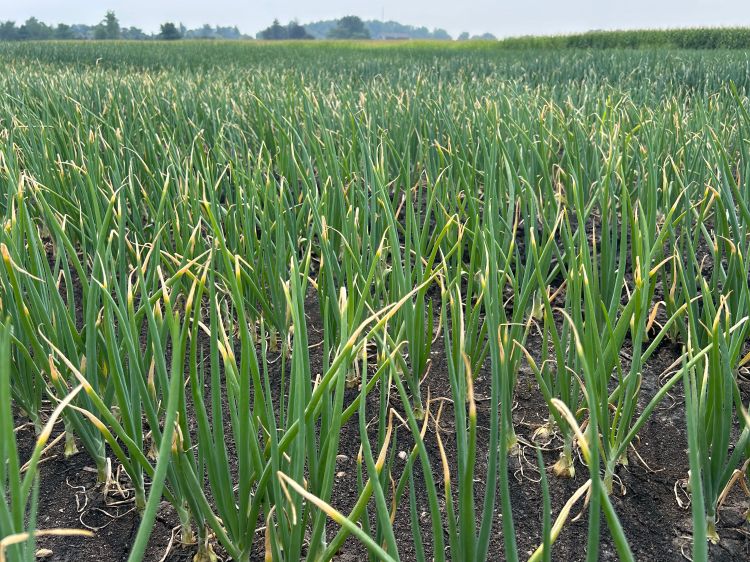
Weather
We’ve had an unusually smoky week as northwest winds aloft brought us Canadian air. Here in Michigan, weak winds batted the smoke one way then another, keeping it over the state. Unfortunately, there are now newer fires here in the western United States. How might the smoke impact plants? Peak sunshine at midday decreased by 15-20% at Michigan State University’s (MSU) East Lansing Enviroweather station, compared to the previous less smoky week. However, this reduction is measurable but not huge in terms of impacts on plant photosynthesis.
The past week was cooler than normal with higher rainfall totals—up to 2 inches—falling across the southern part of lower Michigan, providing some relief to portions of southwest Michigan. Some areas got less than 0.5 inches. Rainfall deficits of up to 6 inches are present in some portions of central, west central and southwest Michigan. Degree day totals are running one to 1.5 weeks ahead of normal in southern Lower Michigan, with values trending closer to normal further north.
This week’s forecast calls for:
- Occasional showers and thunderstorms are likely Wednesday, Aug. 6, to the north, west and lower Michigan and east upper Michigan, slowly spreading south and east into central and southeast lower Michigan by the evening overnight and through the morning of Aug. 7. A few strong storms possible to the southeast. Prior to the rainfall, mostly fair, windy and very warm Wednesday in southwest lower Michigan. Showers possible again to the north Friday. Mostly fair and cooler statewide Saturday. Rain possible again statewide late Sunday and Monday.
- Precipitation totals of 0.5-0.75 inches for the upcoming week, with most falling early next week.
- High temperatures from the upper 60s north to mid-80s south Wednesday, cooling to the 70s Thursday through this weekend. Lows from the upper 40s north to upper 50s south Thursday falling to the upper 40s and low 50s Friday through this weekend.
- Medium range outlooks call for a progressive pattern with temperatures gradually warming back to near to above normal levels with normal to above normal precipitation totals through mid-June.
Post harvest conditions
On many farms, the fruiting vegetables and cucurbits are starting to come in heavily, and on some farms they are stored before market under refrigeration. According to “Knott’s Handbook for Vegetable Growers,” most fruiting vegetables and cucurbits will do well at around 50 degrees Fahrenheit. Sharing space with cold-tolerant veggies, leafy greens, roots and brassicas, can reduce fruit quality. On mixed vegetable farms, dealing with both the cold-tolerant crops and the intolerant ones can be beneficial to develop two cooling rooms at different temperatures. Anecdotally, storing fruiting vegetables closer to 50 F or warmer can also reduce the “sweat” that appears when pulled out for market.
Crop updates
Asparagus
Between 5-9 disease severity values (DSVs) accumulated between July 29 and Aug. 1 at nine sensors Michigan State University Extension and partners are monitoring in Oceana and Mason County asparagus. A fungicide application would have been indicated for Monday, Aug. 4, if nothing had been applied since July 23-26 (assuming a 15 DSV interval).
Cucurbits
Cucumber and summer squash harvest continues. In some places, pumpkins are ripening early.
Powdery mildew and squash bug were present in an unsprayed pest demonstration garden MSU Extension is monitoring in west central Michigan. Squash bug eggs were being laid on top (atypical) and under leaves (typical).

Powdery mildew fungicides are discussed in this article.
Got squash bug to control, but worried about bees? Sivanto Prime is one product with squash bug activity that, according to the label, is less toxic to pollinators. It mainly controls insects with sucking mouthparts (aphids, true bugs), so it may not help with striped cucumber beetle. Assail (acetamiprid) also has squash bug activity; the label says it is most effective for freshly laid eggs and nymphs. Pyrethroids are probably most effective but will be toxic to pollinators for the duration they are active. Timing applications when bees are less active can help.
Brassicas and greens
Black rot has been reported. Flea beetles can be seen feeding on collards and other brassicas. Caterpillar damage is also present.
Cross-striped cabbage worm was active at one west central Michigan location for the past two weeks. This pest is typically very spotty within fields, but causes significant damage on the few plants it colonizes. The caterpillars feed as one big happy family. CATERPILLAR CARPET BOMB!
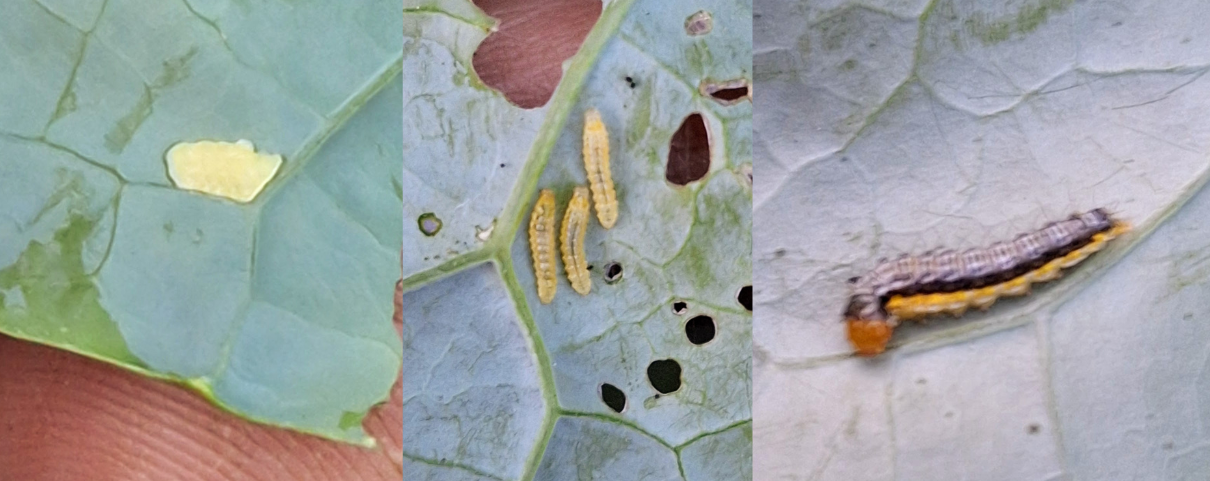
Fruiting vegetables
Field harvest has begun for many growers. Thrips and stink bug damage can be found on fruits. Other fruit quality issues from environmental conditions are prevalent. According to the University of Missouri article, “Tomato Fruit Disorders,” hot weather with fluctuating moisture levels are the catalysts that make many of these issues happen, but a lack of potassium plays a background role as well. Nitrogen and calcium can both “outcompete” potassium in the plant, even if an adequate supply of potassium is present.
Growers who fertilize through the drip irrigation systems have an opportunity to augment their program to deliver less of these competing nutrients and more potassium. Picking tomatoes in the breaker or pink stage is an effective way to bypass many of the cracking issues but is dependent on your space and time availability to ripen them off the plant. It is common to ripen fruit off the plant under refrigeration between 50 and 68 F, or in open airy spaces such as a back room of the market, garage or barn. However, when ripening like that, it is important to remove rotters and manage critters like fruit flies, birds and mice.
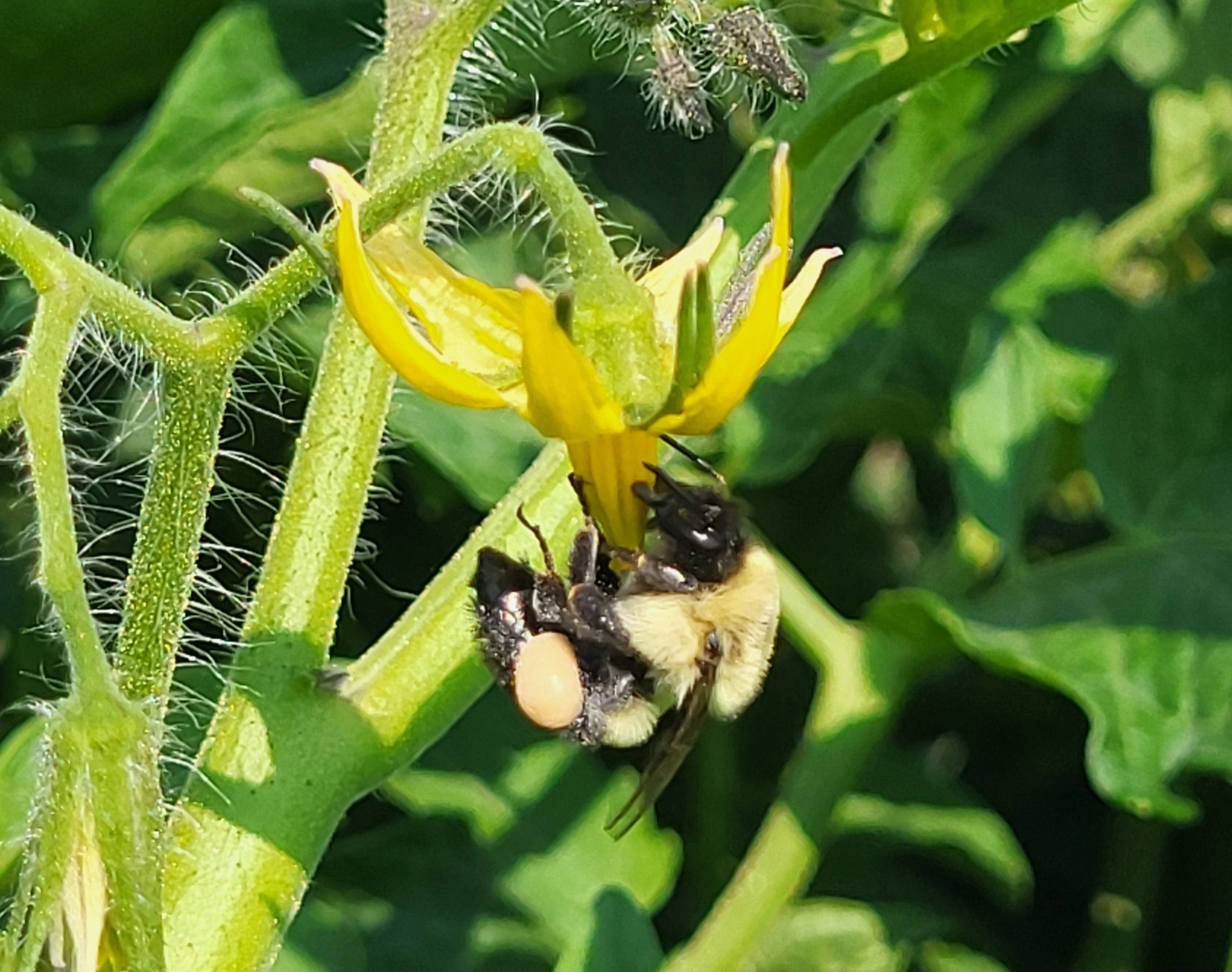
While tomato flowers can be wind-pollinated, bee pollination can contribute to higher tomato yields. Bumble bees sonicate or “buzz pollinate” blossoms by grabbing onto anthers and furiously vibrating. This action causes the anthers to shed pollen which falls onto the stigma (tomatoes have botanically perfect flowers and are usually self-pollinating), which leads to fruit development. Read more about this fascinating interaction in this article from Ohio State University Extension and this slide deck from University of Maryland Extension.
Hornworms were abundant in unsprayed tomatoes at a pest demonstration garden in west central Michigan. It is easiest to spot the grenade-shaped frass (poop) first. The caterpillars are large but can be remarkably hard to see. Many products are available for control.
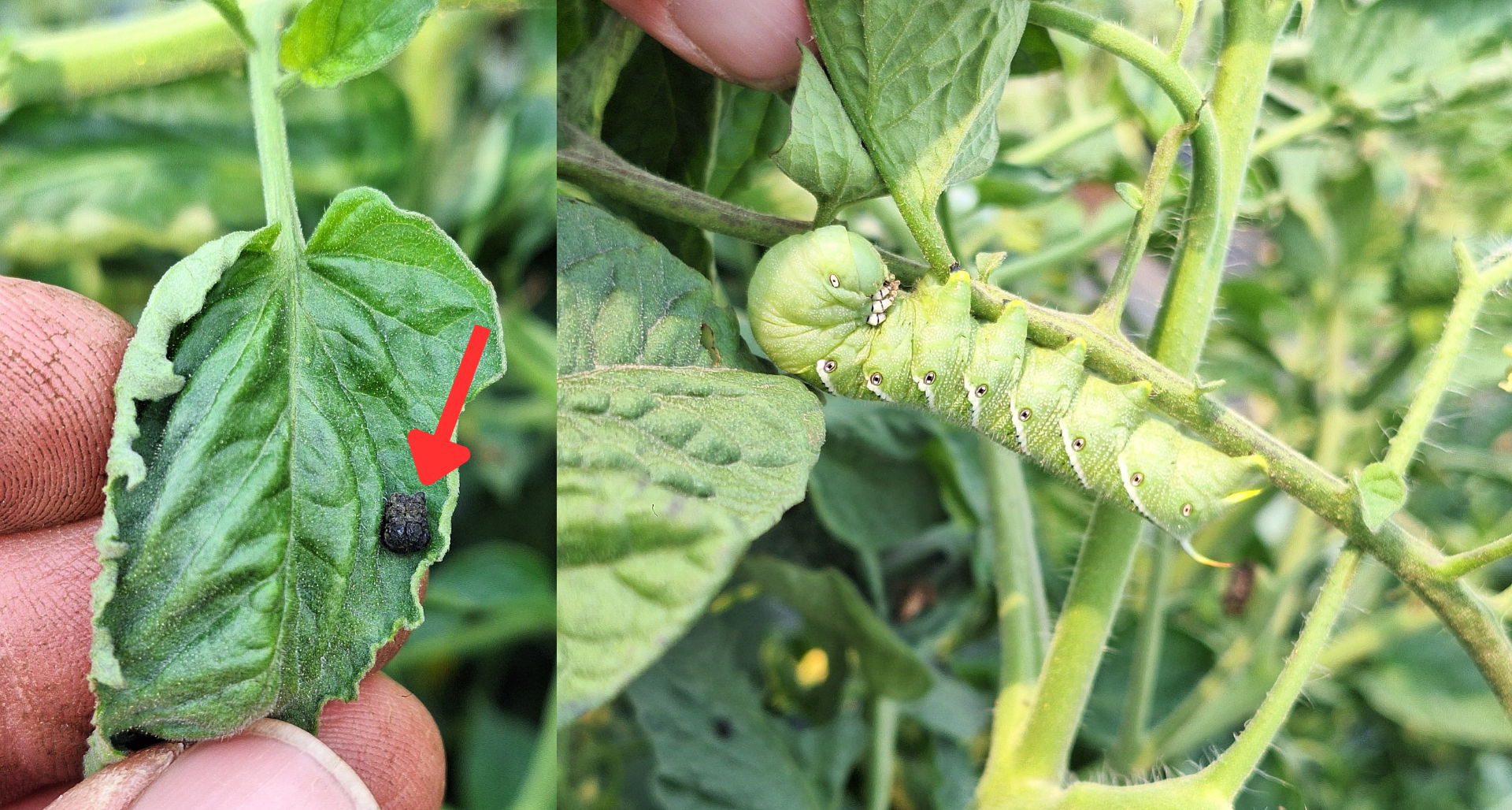
Onions and garlic
In some areas, onions are maturing early with smaller sizes.
Carrots and celery
Scouts have observed celery leaf tier caterpillars in the tops of celery plants at some locations. This pest typically stays in the top leaves but can move down into the heart in hot weather. Typical caterpillar sprays are effective. Growers have been managing aphids and in some cases spider mites as well. Aster leafhopper numbers have been on the decline.
From July 29 to Aug. 1, 8-9 DSVs accumulated at two carrot monitoring sensors tracked by Michigan State University Extension and partners in Oceana County. A fungicide application would have been indicated at these locations for Monday, Aug. 4, if nothing had been applied since July 25 (assuming a 15 DSV interval). Possible symptoms of Alternaria were showing up on older leaves at some locations. Read this article for more about disease symptoms in carrots. Group 7 fungicides such as Merivon and labeled members of the Luna series are highly effective and good to incorporate early in spray programs and during periods of high DSV accumulation.

Aster yellows symptoms are clearly visible in some west central Michigan carrots. These can include yellow foliage, bronzed foliage, distorted new growth and/or hairy roots. These symptoms are the result of infection earlier in the season.
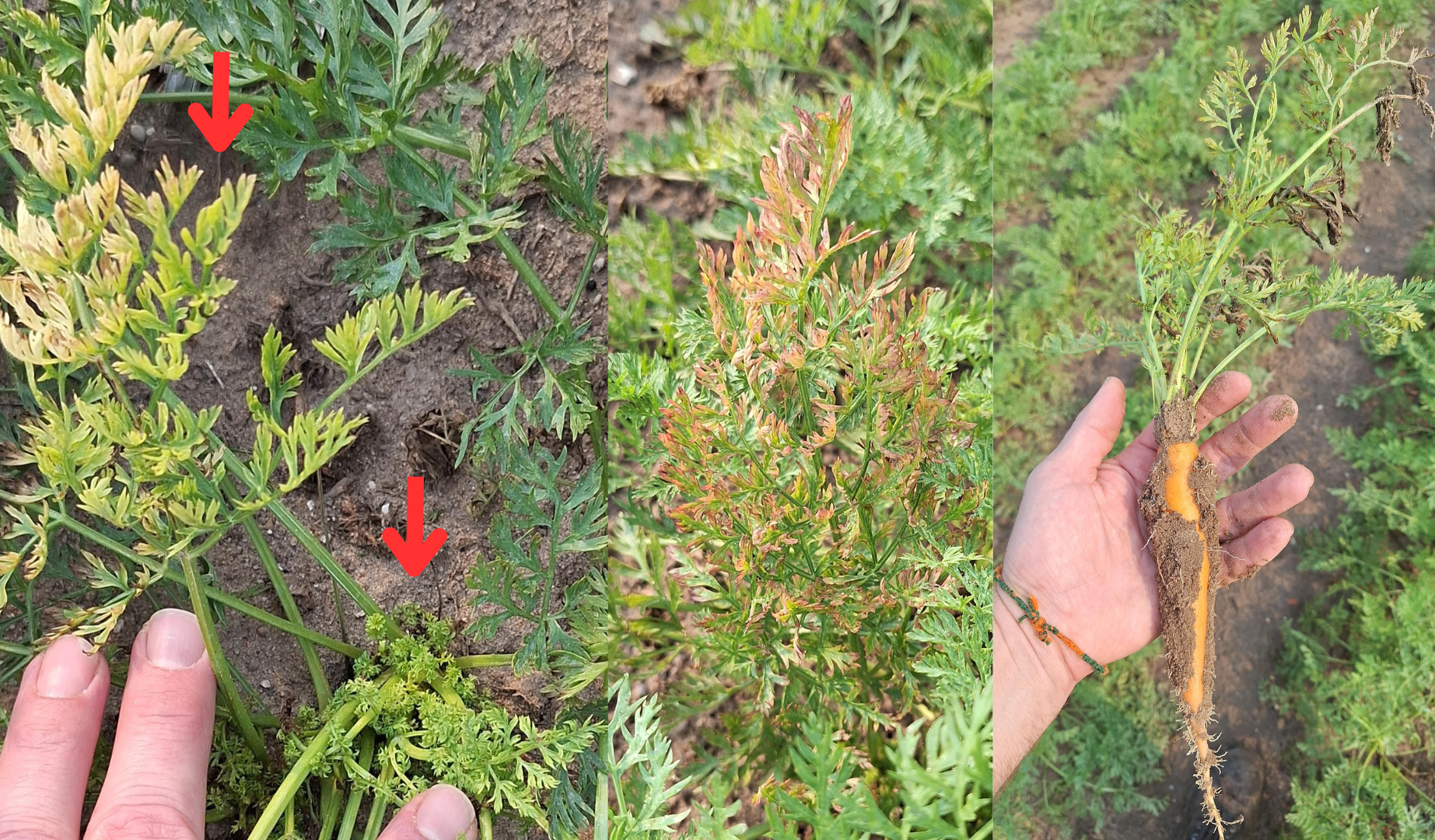
Sweet corn
Corn earworm captures were relatively low this week across sites MSU is monitoring. West central Michigan scouts also report a lull in numbers as of Tuesday, Aug. 5.
Table 1. Corn earworm captures. Total in trap for week1 (avg # per night2).
| Week | Saginaw Co.3 | Oceana Co.4 | Ottawa Co.4 | Monroe Co.3 | Genesee Co.3 | Lapeer Co.3 | Lapeer Co.3 |
|---|---|---|---|---|---|---|---|
| 30-Jun | - | 42 (7.0) | 265 (33.1) | - | - | - | - |
| 7-Jul | 3 (0.4) | 122 (17.4) | 30 (6.0) | - | - | - | - |
| 16-Jul | 6 (0.9) | 76 (10.9) | 4 (0.6) | 6 (0.86) | 2 (0.3) | 9 (1.3) | 2 (0.3) |
| 23-Jul | 0 (0.0) | 13 (1.9) | 1 (0.1) | - | 0 (0.0) | 0 (0.0) | 0 (0.0) |
| 30-Jul | 1 (0.1) | 4 (0.6) | 21 (4.2) | 0 (0.0) | 0 (0.0) | 0 (0.0) | 0 |
| 6-Aug | 0 (0.0) | 2 (0.3) | 4 (0.8)5 | 0 (0.0) | 0 (0.0) | 0 (0.0) | 0 (0.0) |
1Total number collected since last trap check; 2The total number divided by the number of nights since the last trap check; 3Cloth Heliothis traps track trends but catch less moths overall; 4Wire Harstack traps capture more moths. 5Trap fell over so catches may be low.
To our south, for the past week corn earworm numbers were mostly in the single digits in the trapping network maintained by Purdue University, though two traps caught large numbers this morning, with low numbers in Ohio State University’s network. The Insect Forecast website predicts a moderate of additional migration through tomorrow, with highest risk in West Central and Southwest Michigan. It is getting to be the time of year when numbers can increase, so keep checking traps. Once field corn finishes pollination, risk will also increase.
Western bean cutworm numbers declined at three locations MSU is monitoring, with numbers possibly past peak in Ohio State University’s trapping network.
Table 2. Western bean cutworm captures. Total in trap for week1 (avg # per night2).
| Week | Genesee Co. | Oceana Co. | Ottawa Co. |
|---|---|---|---|
| 30-Jun | - | 0 (0.0) | 16 (2.0) |
| 7-Jul | - | 13 (1.8) | 17 (3.4) |
| 16-Jul | 2 (0.3) | 54 (7.7) | 67 (9.6) |
| 23-Jul | 6 (0.86) | 68 ( 9.7) | 316 (35.1) |
| 30-Jul | 4 (0.6) | 95 (13.6) | 70 (14) |
| 6-Aug | 1 (0.1) | 20 (0.3) | 51 (0.8) |
1Total number collected since last trap check; 2The total number divided by the number of nights since the last trap check.
Cybercrime survey
If you have been affected by cybercrime or are nervous about the potential for it, please take this very short survey regarding cybercrime experiences. The survey/research is being led by Tom Holt, professor at the School of Criminal Justice at MSU. For a Michigan Farm News story about the study, see “MSU cybercrime survey to help MI farmers before the hack happens.”
Produce Food Safety On-Farm Readiness Reviews
Schedule an On-Farm Readiness Review today for a two-hour educational visit that takes place during the harvest season and is meant to be casual and low stress. Everything discussed during an On-Farm Readiness Review is confidential and focuses on ways to reduce risks in relation to produce safety. There is no pressure to take our advice either, we are just here to support you in your produce safety efforts.
On-farm soil moisture monitoring research opportunity
MSU researchers are looking for 20 farms to install soil moisture probes in up to two fields. Cooperators get access to real-time data for both monitoring stations for three growing seasons (fall 2025-fall 2028). Refer to the flier for more details.
Reach out to Alex Kuhl (kuhlalex@msu.edu) if you might be interested or have questions.
Events
- August 12, 12-1 p.m., Seed Treatment Webinar Series
- August 15, 8:30-11:30 a.m., Farming Forward succession planning seminar at Saginaw Valley Research and Extension Center
- August 18–19, Northern Michigan Small Farm Conference
- August 19, 12-1 p.m., Seed Treatment Webinar Series
- August 20, 8 a.m.-3:30 p.m., 2025 Midwest Mechanical Weed Control Field Day
- August 20, 10 a.m.-2 p.m., Organic Vegetable Pest Management Field Day
- August 26, 12-1 p.m., Seed Treatment Webinar Series
- September 4, 5-8 p.m., Cover Crop Workshop at the Saginaw Research and Extension Center
- October 11, 1-3 p.m., Farm Field Day with Fisheye Farm
- October 21, 12-1 p.m., What are Your Farm Certification Goals? - TOPP Online Webinar
- October 28, 12-1 p.m., Organic Market Premium - How Much Can I Expect to Get for My Products? - TOPP Online Webinar
- November 4, 12-1 p.m., How to Make Money in Organic Farming - TOPP Online Webinar
- December 9-11, Great Lakes Expo
This work is supported by the Crop Protection and Pest Management Program [grant no 2024-70006-43569] from the USDA National Institute of Food and Agriculture. Any opinions, findings, conclusions, or recommendations expressed in this publication are those of the author(s) and do not necessarily reflect the view of the U.S. Department of Agriculture.



 Print
Print Email
Email




